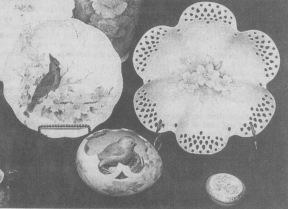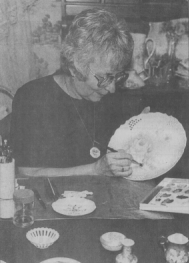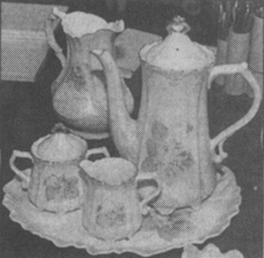Family Painter
Turns Childhood Wish
Into Fine Art
- By MARGARET DWIGGINS
Staff Writer McCOMB
Return to the Gallery Page

China is often adorned with paintings of birds, fruit or flowers. Designs
can be painted on any piece of china that can withstand the heat of kiln
firing between 1,500-1,700 degrees. Hand-painted items are fired several
times and the paint does not dry until the piece is fired.
As a young girl, Mary Ewing used to marvel at her mother's set of hand-painted Japanese plates. It made her wish she could create something as beautiful.
Many years later she attended an art show sponsored by the Findlay Art League and commented to one of the league members that she had always wanted to learn to paint china (or china paint, as the art is known). The next day she was contacted by someone who was starting new china painting class.
That was many years ago and ever since then Mrs. Ewing has honed her skills in the art of china painting. For the past 21 years, hardly a day has gone by that Mrs. Ewing hasn't sat down and spent some time china painting.
One thing Mrs. Ewing was quick to point out is that china painting is a fine art and not a craft. It differs greatly from ceramics in that china is made from a finer grade of clay which, when held up to the light, is actually translucent. Painted china also has a hard glaze, whereas ceramic ware has a soft glaze.
The fine detail in china painting takes a delicate hand. Mrs. Ewing explained that a piece of china is painted and fired many times before a painted piece is completed, and if the paint is applied too heavily it is prone to chipping.
When applying designs on china, Mrs. Ewing uses an assortment of brushes in varying sizes, and she sometimes uses a stylus to trace designs on to the china before she starts to paint. Many times, however, she just picks up a piece and paints free-hand, creating flowers, leaves and other designs with ease. She adds her signature to each piece with a closed quill pen.
Mary Ewing demonstrates her technique for china painting. Mrs. Ewing, who has been china painting for several years, is able to achieve the fine detail in her paintings by using an assortment of brush sizes and tools. She is a member of the Findlay Area China Painters group, which meets regularly to paint together and share techniques.

The paint used by china painters originates in a powder form and consists of ground minerals and ground glass. The powder is mixed with oil on a solid sheet ground glass until it is the consistency of toothpaste. Enamel can also be mixed into the paint, making the finished color shinier and darker.
For especially fancy pieces, one can even buy gold paint that is made with 14K gold.
Among Mrs. Ewing's china painting supplies is a color palate she has created, which is helpful when she re-starts a project and has to mix a color to match exactly. Color charts can also be referred to, but "experience is the best teacher" when mixing paints, Mrs. Ewing said.
China provides a unique painting surface. It will not absorb the paint, and the paint will not dry until it has been fired in a kiln. So if a china painter makes a mistake or is unhappy with his or her work, the paint can be easily wiped off, even months later.
"If you don't like it, don't fire it, because once it's fired, it's (the paint) is on., Mrs. Ewing said.
She demonstrated how she uses a rubber-tipped "wipe-out" tool to correct mistakes and remove paint. While painting a tiny rose, she also showed how highlights are created by removing paint with the wipeout tool.
Mrs. Ewing chuckled when she recalled an instance several years ago when one of her now-grown daughters picked up a piece Mrs. Ewing was working on, asking if she was finished with it while at the same time swiping her finger across the paint, which was not dry.
Mrs. Ewing is an active member of the Findlay Area China Painters club, which meets regularly to work on common projects, such as pieces with an Oriental theme, and to share techniques. As an example of a technique picked up at a club meeting, Mrs. Ewing pointed to a piece with a painted background which was given a marbleized look by spritzing the paint with window cleaner.
She also belongs to a china painters group in Mansfield and is involved with the World Organization of China Painters and the International Porcelain Artists and Teachers organization. The organizations provide continuing education through publications and by offering seminars.
In addition to creating her own china designs, Mrs. Ewing is also a collector of painted china. She is especially fond of a plate she found at an antique. show which was signed by George Leykauf. a well-known china painter from early in the century. When looking for antique plates, Mrs. Ewing recommended looking on the bottom of the piece for a date.
Occasionally, Mrs. Ewing buys antique plates devoid of any decoration and paints her own.
However, most of the china pieces she paints are obtained new through a mail-order catalogue. and the selection is not limited to dishes.
"You can paint on anything that you can fire," Mrs. Ewing noted, pointing out some of the things she has tried, including small refrigerator magnets, ring boxes and Christmas ornaments. China can be purchased glazed and unglazed.
Once painted, the items are fired in a kiln heated to between 1 500 to 1,700 degrees. The things you can paint and the designs painted on them are only "limited to your imagination, time and energy," Mrs. Ewing said.
